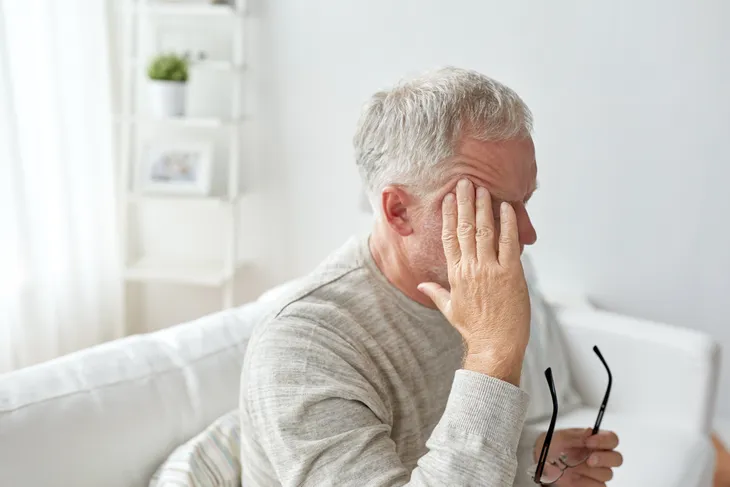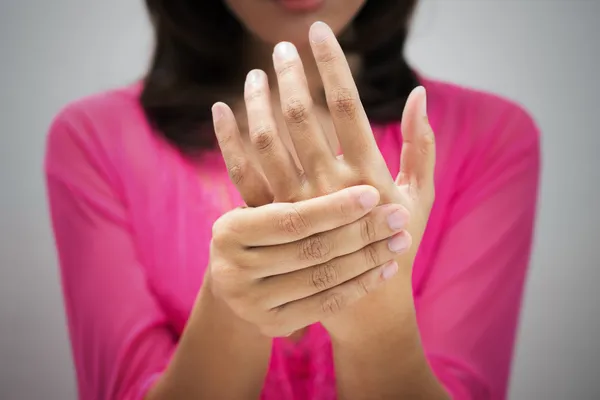A stroke, or cerebrovascular accident (CVA), is a scary experience. It occurs when the blood supply to the brain is impeded or cut off completely (known medically as ischemia). As a result, the brain stops functioning normally, and oftentimes, the body’s muscles, reflexes, and senses are all affected.
Luckily, a stroke can be treated, but getting emergency medical attention as quickly as possible is the key to survival. That’s why it’s vital to recognize the following 15 warning signs of a stroke…
1. Loss of Balance
The onset of a stroke will cause extreme physical turmoil, and victims often have trouble walking, lose their balance and coordination completely, and even have trouble sitting down without falling. You can stumble and it feels next to impossible to get your balance. Dizziness (discussed in more detail later in this article) is a common symptom that goes along with balance problems. Walking and simple coordination can become difficult as a result of the dizziness.
While loss of balance is a symptom of a stroke, you can also experience it post-stroke. You may continue to feel dizzy and insecure in your ability to walk without stumbling or falling. According to the Stroke Association, you are more likely to experience balance problems if the stroke affects the left side of your body. Some stroke survivors may only feel mild balance issues, while others may have severe loss of balance, which can impact their quality of life.
2. Weakness
A sudden loss of strength in the muscles of the face, arm, leg—even if it’s just temporary—can signal an ongoing stroke. Many patients complain of numbness or tingling in the left arm or shoulder that comes on suddenly and gradually worsens. Sometimes, complete muscle failure can occur, where you can’t lift an arm or bear weight on the affected leg.
Muscle weakness can occur after a stroke as well, especially if you’re immobile for a long period of time. Intense physical therapy can help teach stroke survivors how to better control their weak muscles and do some small tasks. While some people who’ve had a stroke never regain their ability to move one or both sides of their body, physical therapy has lead to many stroke survivors regaining their ability to heal, allowing them to walk and to do the other regular day-to-day activities they did before the stroke.
3. Facial Paralysis
Oftentimes, a stroke affects the facial muscles, where one side of the face droops or goes totally numb causing the face to appear non-symmetrical. This is the most noticeable symptom. If you suspect someone is having a stroke, ask the person to smile. This is a quick way to identify if they are indeed having a stroke. If facial paralysis occurs, get them emergency medical attention immediately. Even if the non symmetrical smile or speech difficulty isn’t from a stroke, it’s still a sign that something serious is wrong.
Rehabilitation therapy plays a crucial role in recovering from facial paralysis. Some stroke survivors fully recover from facial paralysis over time, but it is permanent for many people. This symptom and often permanent effect of a stroke is caused by either lack of oxygen to the facial nerve in the brain or bleeding that puts pressure on nerves and tissues.
4. Difficult Speech
Difficult or slurred speech is another obvious warning sign of a stroke. If someone suddenly has difficulty speaking or forming intelligent sentences, it could indicate a stroke. Observers often explain it as watching someone helpless trying to talk or a look of sudden confusion on the affected person’s face. The person experiencing the stroke can have the inability to speak, trouble putting words together in a sentence, or simply trouble focusing on speaking.
Speech can be greatly improved in the first few months following a stroke. The American Stroke Association identifies three speech disorders that can occur after a stroke: aphasia (difficulty or inability to use or comprehend words), apraxia (difficulty initiating or executing movement necessary to speak, despite being physically able to), and oral apraxia (difficulty moving the muscles of the lips, throat, soft palate, and throat for things besides speech, such as smiling). There are comprehensive treatments to help stroke survivors regain their ability to speak normally.
5. Impaired Vision
Those affected by a stroke often explain there is a period prior where they have trouble seeing. They could experience double vision, blurred vision, or complete loss of vision. These vision problems might only be temporary, but observers can test visual aptitude by asking the victim how many fingers they are holding up. If they can’t tell, call 9-1-1.
Many people who’ve had a stroke experience vision problems afterwards, especially if the stroke was on the right side of the brain. You could have blind spots or trouble focusing because of the cells that are destroyed in the visual cortex. While many stroke survivors have impaired vision, medical advances have increased the chance of seeing well enough to do regular things such as shopping, going out for a walk, or even driving. Intense treatment that involves retraining the brain has helped many survivors get some or most of their vision back.
6. Lack of Understanding
A person suffering a stroke will often have difficulty understanding certain statements and commands in the days leading up to the actual stroke. This might also present when they try speaking or carrying on a conversation. You might not think anything of the confusion or difficulty understanding things (you may attribute it to fatigue or stress) but it’s important to know that it’s an early warning sign of a stroke.
The earlier you can identify you’re having a stroke, the better your chances are of full recovery. The longer you’re having a stroke without treatment and attention from a medical team, the more damage it can cause to your brain. It can also increase your chances of permanent damage resulting in severe disability. While it may seem like a small issue, it’s never a bad idea to get checked out if there’s cause for concern. Ruling out a stroke or getting early treatment could save your life.
7. Headache
The sudden onset of a severe, debilitating headache or migraine that is not normal or usual is common prior to a stroke. In fact, many stroke victims explain a headache so painful that it feels like being struck by lightning, as it causes extreme nausea and even potential collapse. The headache could include visual problems, such as an aura. An aura is similar to the spots you see from turning on a light bulb after being in a dark room or a camera flash that leaves spots and makes you blink. The difference is, it doesn’t go away after a few seconds.
It can be extremely difficult for someone who gets regular migraines or headaches, especially if their headaches often come with auras (something common in migraine sufferers), to recognize the symptom as a stroke. This makes it dangerous because you might not seek treatment when you should, decreasing your chances of full recovery and increasing the chance of permanent damage to your brain.
8. Loss of Sensation
In the days leading up to a stroke, it’s common for a gradual, or even a total, loss of vibratory sensation (or feeling) on the skin. Nerves in your brain send signals to different areas of your body. When you’re having a stroke, these signals can be interrupted or stop functioning properly, causing reduced or complete loss of sensation. You could experience it in one or several areas of your body, depending on the affected nerves. The other senses, such as smell, taste, and hearing, can also be fully or partially affected.
Unfortunately, stroke survivors can experience difficulties with sensation after a stroke, including hypersensitivity to touch, loss or reduced temperature sensation, not knowing where a limb is without looking, and reduced sensitivity to touch. It can be frustrating and upsetting to have temporary or permanent damage of this sense, and depending on the severity, it may greatly impact your ability to do the normal, everyday things you did before the stroke.
9. Dizziness
When someone is having a stroke, they may have difficulty walking, balancing, or even sitting down properly. This loss of balance can be so severe that many victims of a stroke feel like the world is spinning and they can’t find their equilibrium (i.e., vertigo). The dizziness can be so severe you feel nauseous, and it may even cause vomiting. The dizziness can be misdiagnosed as vertigo which puts the patient at a potential risk of increased damage. In some cases, the person having the stroke only experiences severe dizziness for a short time, which is why it can be hard to diagnose stroke as the cause.
While severe dizziness happens to many people who have a stroke, sometimes the dizziness is not accompanied by other typical symptoms of stroke, making it hard to recognize what’s really happening. Mini-strokes, also referred to as transient ischemic attacks (TIAs), happen often without knowing it, and there’s a fairly good chance a regular stroke will occur after experiencing a mini stroke.
10. Lack of Reflexes
It is also common to experience a decrease in or loss of reflexes with a stroke. For instance, many stroke victims complain of trouble swallowing when eating. The American Stroke Association says that up to 65-percent of people who have a stroke can develop dysphagia, or difficulty swallowing. Since this is a predominant symptom and after-effect of a stroke, it’s always examined when you’re in the hospital. There’s a swallow test that can be done, and if you don’t pass the test a speech-language pathologist will be needed for rehabilitation.
The temporary or permanent damage from a stroke varies from person to person, but one thing remains the same the earlier you seek medical attention when having a stroke, the better your chances are, not just for survival but also recovery. Knowing the warning signs and symptoms of a stroke can help protect you and those around you. If there’s even an inkling you or someone you’re with is having a stroke, call 9-1-1 right away.
11. Confusion
Not surprisingly, people who are having a stroke will become confused. This is likely due to the fact that their brain is not functioning properly. On top of all that, if it is stroke-related, they likely cannot speak or see clearly either. They are experiencing all kinds of uncomfortable symptoms in their body such as numbness, weakness, and dizziness, which causes them to become confused because they are typically unaware of what is happening.
If you ever become suddenly (the keyword is “sudden” because these symptoms will often appear out of nowhere) confused and have trouble understanding what people are saying, along with some of these other symptoms, it could be because you’re having a stroke.
12. Trouble Reading
In addition to having trouble speaking or understanding what other people are saying, victims of a stroke will also have difficulty reading. This is another key sign that something is seriously wrong with the brain and they need medical attention right away.
A stroke can affect one side of the body more than the other, and if it’s more present in the left side of the brain, which controls language, according to Women’s Health. “It can affect how you speak, your ability to understand what someone is saying, or your reading or writing skills.”
13. Numbness
This one goes hand in hand with slide number two which cited weakness as one of the main symptoms of a stroke. While many people feel weak in the face, arm, leg, or one side of their body, they can also feel numbness.
Because the brain controls each side of the body with the opposite hemisphere, a stroke typically affects one side of the body more than the other which is why people will only feel numbness in one side, either the left or the right. As a result, the side of the brain that actually is having the stroke is opposite the affected side of the body. In other words, a stroke in the left brain will affect the right side of the body.
14. Hiccups
Similar to heart attacks, women and men can experience different symptoms when it comes to a stroke. For example, women are more likely to experience hiccups when suffering from a stroke. Since hiccups are commonly associated with things like indigestion, they are more likely to get an incorrect diagnosis. In a medical press release, Dr. Diana Greene-Chandos, a neurologist and Director of Neuroscience Critical Care said, “[Women] actually can have hiccups with a little bit of chest pain with their stroke symptoms, sometimes sending them down the pathway of looking for either heart disease or indigestion.”
A study conducted by the Ohio State University found that many women are unaware of the fact that they could experience unique symptoms of stroke, such as hiccups. “Of 1,000 women surveyed, only one in 10 was aware that hiccups that occur with unusual chest pain is an early warning sign of stroke in women,” said researchers from Wexner Medical Center in Columbus, OH. It’s important for women to be in the know when it comes to their unique symptoms and risk factors, because it could save their life.
15. Altered Mental Status
According to Healthline, altered mental status is a term clinicians may use when referring to symptoms such as, drowsiness, unresponsiveness, disorientation, confusion, sudden behavioral change, agitation, and hallucination, which could be due to a stroke.
A 2009 study comparing the acute differences between stroke symptoms in men and women found that altered mental status is the most common nontraditional symptom of stroke. Women are more likely to experience an altered mental state while suffering from a stroke (23-percent), whereas only 15-percent of men reported these symptoms. Healthline also notes, “Women are about 1.5 times more likely to report at least one nontraditional stroke symptom.”


















